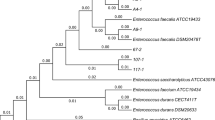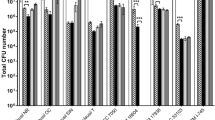Abstract
Probiotics become important bacteria in our daily life due to their benefit on human health. In this study, a subset of bacterial strains from children was isolated and evaluated for beneficial probiotic traits such as antimicrobial activity, bile and acid tolerance, and pathogenic cell adherence inhibition. The strain with the best antimicrobial activity was selected for further characterization on the basis of morphological, biochemical characteristics and gene sequence. This strain was Gram-positive, oxidase and catalase-negative, and it produced acids by fermenting sugar and starch as carbon sources. Additionally, it could only hydrolyze bile-esculin, but not red blood cells. The 16S rDNA gene sequence revealed that this strain was Enterococcus faecalis. Interestingly, this strain effectively inhibited a variety of pathogens by acid and bacteriocin production and was bile-tolerant, able to survive under acidic condition. In the safety assessments, E. faecalis MTC 1032 could adhere to host epithelial cells and evidently inhibited pathogenic cell adhesion as demonstrated by cell reduction over time of E. coli ATCC 25922 and S. typhimurium ATCC 13311 on Caco-2 cell line. In summary, it was clearly represented that E. faecalis MTC 1032 provided suitable properties and could be a candidate as a probiotic strain in food supplements.




Similar content being viewed by others
References
Al Atya AK, Drider-Hadiouche K, Ravallec R, Silvain A, Vachee A, Drider D (2015) Probiotic potential of Enterococcus faecalis strains isolated from meconium. Front Microbiol 6:227
Alam S, Mushtaq M (2009) Antibiotic associated diarrhea in children. Indian Pediatr 46:491–496
Allameh SK, Daud H, Yusoff FM, Saad CR, Ideris A (2012) Isolation, Identification and characterization of Leuconostoc mesenteroides as anew probiotic from intestine of snakehead fish (Channa striatus). Afr J Biotechnol 11:3810–3816
Belguesmia Y, Madi A, Sperandio D, Merieau A, Feuilloley M, Prévost H, Drider D, Connil N (2011) Growing insights into the safety of bacteriocins: the case of enterocin S37. Res Microbiol 162(2):159–163
Campos CA, Rodriguez O, Calo-Mata P, Prado M, Barros-Velazquez J (2006) Preliminary characterization of bacteriocins from Lactococcus lactis, Enterococcus faecium and Enterococcus mundtii strains solated from turbot (Psetta maxima). Food Res Int 39:356–364
Canani RB, Cirillo P, Terrin G et al (2007) Probiotics for treatment of acute diarrhoea in children: randomised clinical trial of five different preparations. BMJ 335(7615):340
Carlos AR, Santos J, Semedo-Lemsaddek T, Barreto-Crespo MT, Ten Reiro R (2009) Enterococci from artisanal dairy products show high levels of adaptability. Int J Food Microbiol 129:194–199
Casey PG, Casey GD, Gardiner GE et al (2004) Isolation and characterization of anti-Salmonella lactic acid bacteria from the porcine gastrointestinal tract. Lett Appl Microbiol 39:431–438
Chaveerach P, Lipman LJ, van Knapen F (2004) Antagonistic activities of several bacteria on in vitro growth of 10 strains of Campylobacter jejuni/coli. Int J Food Microbiol 90:43–50
Del Giudice MM, Leonardi S, Maiello N, Brunese FP (2010) Food allergy and probiotics in childhood. J Clin Gastroenterol 44:22–25
Floch MH (2010) Probiotic therapy for ulcerative colitis. J Clin Gastroenterol 44:237–238
Franz CM, Huch M, Abriouel H et al (2011) Enterococci as probiotics and their implications in food safety. Int J Food Microbiol 151:125–140
Franz CM, Schillinger U, Holzapfel WH (1996) Production and characterization of enterocin 900, a bacteriocin produced by Enterococcus faecium BFE 900 from black olives. Int J Food Microbiol 29:255–270
Franz CM, Stiles ME, Schleifer KH, Holzapfel WH (2003) Enterococci in foods—a conundrum for food safety. Int J Food Microbiol 88:105–122
Fuller R (1986) Probiotics. Soc Appl Bacteriol Symp Ser 15:1–7
Fuller R (1989) Probiotics in man and animals. J Appl Bacteriol 66:365–378
Gu RX, Yang ZQ, Li ZH et al (2008) Probiotic properties of lactic acid bacteria isolated from stool samples of longevous people in regions of Hotan, Xinjiang and Bama, Guangxi, China. Anaerobe 14:313–317
Guo XH, Kim JM, Nam HM et al (2010) Screening lactic acid bacteria fromswine origins for multistrain probiotics based on in vitro functional properties. Anaerobe 16:321–326
Hlivak P, Odraska J, Ferencik M et al (2005) One-year application of probiotic strain Enterococcus faecium M-74 decreases serum cholesterol levels. Bratisl Lek Listy 106:67–72
Hongpattarakere T, Chanthachum S, Buntin N (2008) Screening of lactic acid bacteria from gastrointestinal tracts of marine fish for their potential use as probiotics. Songklanakarin J Sci Technol 30:141–148
Jankovic I, Sybesma W, Phothirath P et al (2010) Application of probiotics in food products—challenges and new approaches. Curr Opin Biotechnol 21:175–181
Jin LZ, Marquardt RR, Zhao X (2000) A strain of Enterococcus faecium (18C23) inhibits adhesion of enterotoxigenic Escherichia coli K88 to porcine small intestine mucus. Appl Environ Microbiol 66:4200–4204
Kaewsrichan J, Chandarajoti K, Kaewnopparat S et al (2007) Evaluation of lactobacilli containing suppository formulation for probiotic use. Mahidol Univ J Pharm Sci 34:1–8
Kim DH, Austin B (2008) Characterization of probiotic carnobacteria isolated from rainbow trout (Oncorhynchus mykiss) intestine. Lett Appl Microbiol 47:141–147
Kim PI, Jung MY, Chang YH et al (2007) Probiotic properties of Lactobacillus and Bifidobacterium strains isolated from porcine gastrointestinal tract. Appl Microbiol Biotechnol 74:1103–1111
Kligler B, Cohrssen A (2008) Probiotics. Am Fam Physician 78:1073–1078
Koebnick C, Wagner I, Leitzmann P et al (2003) Probiotic beverage containing Lactobacillus casei Shirota improves gastrointestinal symptoms in patients with chronic constipation. Can J Gastroenterol 17:655–659
Kramer J (1977) Inhibition of different serotypes of Listeria monocytogenes by enterocins in solid and liquid media. J Med Microbiol 10:367–372
Krammer HJ, Schlieger F, Harder H et al (2005) Probiotics as therapeutic agents in irritable bowel syndrome. Z Gastroenterol 43:467–471
Kühn I, Iversen A, Burman LG et al (2003) Comparison of Enterococcal populations in animals, humans, and the environment—a European study. Int J Food Microbiol 88:133–145
Lauková A, Simonová M, Strompfová V et al (2008) Potential of enterococci isolated from horses. Anaerobe 14:234–236
Linaje R, Coloma MD, Perez-Martínez G, Zuniga M (2004) Characterization of faecal enterococci from rabbits for the selection of probiotic strains. J Appl Microbiol 96:761–771
Lye HS, Kuan CY, Ewe JA et al (2009) The improvement of hypertension by probiotics: effects on cholesterol, diabetes, renin, and phytoestrogens. Int J Mol Sci 109:3755–3775
Miyazaki Y, Kamiya S, Hanawa T et al (2010) Effect of probiotic bacterial strains of Lactobacillus, Bifidobacterium, and Enterococcus on enteroaggregative Escherichia coli. J Infect Chemother 16:10–18
Moussavi M, Adams MC (2010) An in vitro study on bacterial growth interactions and intestinal epithelial cell adhesion characteristics of probiotic combinations. Curr Microbiol 60:327–335
Mukai T, Asasaka T, Sato E et al (2002) Inhibition of binding of Helicobacter pylori to the glycolipid receptors by probiotic Lactobacillus reuteri. FEMS Immunol Med Microbiol 32:105–110
Nagpal R, Kumar A, Kumar M et al (2012) Probiotics, their health benefits and applications for developing healthier foods: a review. FEMS Microbiol Lett 334:1–15
Noguchi S, Okada S, Sugiyama H et al (2012) Lactobacillus plantarum NRIC1832 enhances IL-10 production from CD4 + T cells in vitro. Biosci Biotechnol Biochem 76:1925–1931
Osterlund P, Ruotsalainen T, Korpela R et al (2007) Lactobacillus supplementation for diarrhoea related to chemotherapy of colorectal cancer: a randomised study. Br J Cancer 97:1028–1034
Phalakornkule C, Tanasupawat S (2006–2007) Characterization of lactic acid bacteria from traditional Thai fermented sausages. J Cult Collect 5:46–57
Poeta P, Costa D, Rojo-Bezares B et al (2007) Detection of antimicrobial activities and bacteriocin structural genes in faecal enterococci of wild animals. Microbiol Res 162:257–263
Rodríguez E, Arqués JL, Rodríguez R et al (2012) Antimicrobial properties of probiotic strains isolated from breast-fed infants. J Funct Foods 4:542–551
Sanders ME (2000) Considerations for use of probiotic bacteria to modulate human health. J Nutr 130:384–390
Sanders ME (2003) Probiotics: considerations for human health. Nutr Rev 61:91–99
Sathyabama S, Vijayabharathi R, Bruntha Devi P et al (2012) Screening for probiotic properties of strains isolated from feces of various human groups. J Microbiol 50: 603–12
Strompfová V, Lauková A (2007). In vitro study on bacteriocin of Enterococci associated with chickens. Anaer 13:228–237
Thompson JD, Gibson TJ, Plewniak F et al (1997) The CLUSTAL_X windows interface: Flexible strategies for multiple sequence alignment aided by quality analysis tools. Nucleic Acids Res 25:4876–4882
Tinrat S, Saraya S, Chomnawang MT (2011) Isolation and characterization of Lactobacillus salivarius MTC 1026 as a potential probiotic. J Gen Appl Microbiol 57(6):365–378
Vahjen W, Jadamus A, Simon O (2002) Influence of a probiotic Enterococcus faecium strain on selected bacterial groups in the small intestine of growing turkey poults. Arch Tierernahr 56:419–429
Xu HY, Tian WH, Wan CX et al (2008) Antagonistic potential against pathogenic microorganisms and hydrogen peroxide production of indigenous lactobacilli isolated from vagina of Chinese pregnant women. Biomed Environ Sci 21:365–371
Yu Q, Wang Z, Yang Q (2011) Ability of Lactobacillus to inhibit enteric pathogenic bacteria adhesion on Caco-2 cells. World J Microbiol Biotechnol 27:881–886
Acknowledgements
I would like to thank the Office of the Higher Education Commission, Thailand for supporting the fund under the program of Scholarships for Frontier Research Network for the join Ph.D. Program and Thailand Toray Science Foundation. We would like to extend our thanks to the Thailand Research Fund and Faculty of Pharmacy, Mahidol University (IRG5780007) for financial support on publication. I also thank staffs of the Department of Microbiology, Faculty of Pharmacy, Mahidol University for clarifying several points in this work.
Author information
Authors and Affiliations
Corresponding author
Rights and permissions
About this article
Cite this article
Tinrat, S., Khuntayaporn, P., Thirapanmethee, K. et al. In vitro assessment of Enterococcus faecalis MTC 1032 as the potential probiotic in food supplements. J Food Sci Technol 55, 2384–2394 (2018). https://doi.org/10.1007/s13197-018-3155-5
Revised:
Accepted:
Published:
Issue Date:
DOI: https://doi.org/10.1007/s13197-018-3155-5




